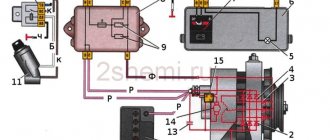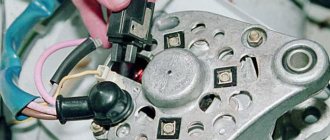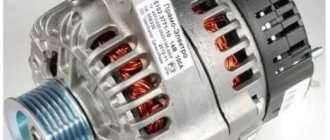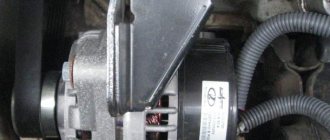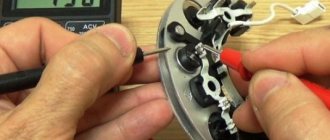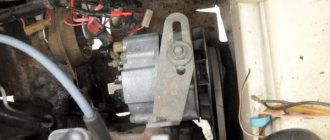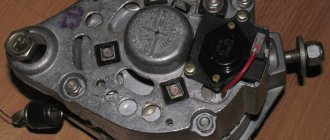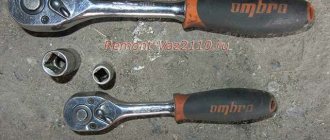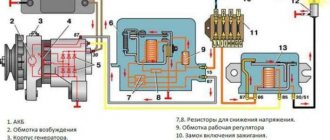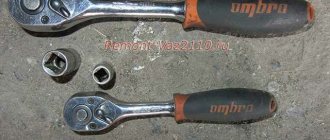As you know, a car generator is designed to provide power to all electrical equipment in the car when the engine is running. This unit in domestic “tens” consists of many elements that ensure its optimal operation. One such device is a diode bridge. What functions does it perform, what do you need to know about its malfunctions, and how is the diode bridge of the VAZ 2110 generator replaced? You can find answers to these and other questions below.
Withdrawal procedure
- First of all, remove the belt from the generator.
2. Disconnect the block from terminal “D” of the generator.
3. Remove the protective cover, unscrew the nut and disconnect the wires from terminal “B+”.
4. Unscrew the tension bolt.
5. Unscrew the top mount of the generator.
6.Remove the tension bar.
7. Unscrew the lower mount of the generator.
8. Remove the spacer bushing.
9. Remove the generator mounting bolt and remove it.
Replacing the generator with power steering, eliminating noise
There was a very strange knocking sound from the engine, when you accelerate and let off the gas there is a knocking sound from the area of the generator and the steering wheel... I struggled with this for a long time, but not very successfully, in order: - the fault was on the belt roller, well, it was a little sensitive and not everything was going well with it okay, I was looking for a roller without play for a long time, but I found it and installed it, it didn’t help with the main knock; -removing the engine and power steering belt and starting the car, the knocking noise disappeared completely, well, for a long time I sinned on the power steering pump, then I replaced it, and it seemed to be better, but after some time this knocking noise came again (((... - I thought, what if it’s a generator It’s noisy, and the voltage was low when you turn everything on to 12V. I went to remove it and look, and then it started... Removing the gene on a car with power steering is another quest... I decided to remove it through the headlight, since it’s not possible to pull the receiver out through the top, but through the bottom, the pump Power steering, removing the pump means draining the oil, and then also pumping it... so it’s easier through the headlight, especially since I also changed the headlights)))
It fits through the headlight just fine, removing the headlight is not difficult))
And so, having removed the generator, I twirled it in my hands and realized that its bearings were running out...
burnt contact, apparently he was punished well at one time)
The contact from the winding is a little burnt, a stub from it remains, the bearings are damaged, the voltage sags, so I bought a new one then)))
dynamo
Dynamo 105A when the old one had 80 Next is the most interesting thing, the secret of the ominous noise is revealed...
bottom of generator mount
and this is the top part of the generator mount
that’s the reason for the noise, a mount broken in two was knocking on another engine mount.
I’ll say right away that finding a new bracket for an engine with power steering was not easy; I never found one in Bryansk! It is attached to the same bolts as the engine mount, but in order to screw it on I had to remove the pump; I removed it directly without twisting the tubes from it, but simply lowering it to the bottom)
The bottom bolt can only be tightened by removing the power steering pump
new generator next to the old one
The new one looks impressive, it has one more winding contact, the regulator is more massive, the voltage on board is 14.2 V and does not consistently respond to the heater and low beams)))) if you turn on everything you can, these are high beams, heated mirrors, emergency lights , heater, reverse, brake light...
The result is I'm happy, there is no noise, the voltage is normal, everything is fine))
- Generator 3800
- Bracket 560
How to install a diode bridge (rectifier unit)?
The diode bridge is installed in strictly reverse order.
Background:
My 140 amp generator started howling in an inhuman voice a long time ago, I removed it and sent it for diagnostics. The diode bridge was ordered to be replaced. As a result, the generator was put aside in the nightstand. My old 80-amp generator recently broke down, and I even took the battery with me... In general, I decided to repair the diode bridge on my own, since a new one costs more than 10 thousand rubles, and the auto electrician didn’t know where to buy 50-amp diodes.
You can’t find diodes in Automotive stores; they are rated at a maximum of 30-35 amps, but my task was to find diodes rated at 50 amps. As a result, after surfing the CARGO online catalog, I found the ones I needed. I'm publishing the numbers.
Diode Cargo 50A - 138634 - 6 pcs. Diode Cargo 50A - 138635 - 6 pcs.
For a 140 ampere generator you need 12 diodes - 6+6, for an 80 ampere generator only 6 - 3+3.
We also need a tool, a soldering iron of at least 50 watts with all the accessories. Dye. I chose heat-resistant silicone. I applied it with a brush, so the layer is thicker. Well, not very smelly hands))
Main stages:
— We dismantle the diode bridge — We remove the old diodes — We halve the diode bridge — We install the diodes (carefully hammer them into the case through a wooden spacer) — We assemble the bridge, solder the contacts — We paint carefully in several layers — We put the bridge in place
On one half of the bridge there are diodes of one type, on the other half - of a different type (different polarity). Having the most ordinary multimeter it will not be difficult to understand where each one is located.
Generator VAZ 2110 and VAZ 2112
The functional purpose of a car generator is to convert engine energy into electricity. The generator starts working after starting the engine from the battery and supports the operation of the ignition system and additional energy consumers.
It is the number of sources loading the generator that affects the operating life of the unit.
How to choose a generator for a VAZ 2110 or VAZ 2112
Due to the similarity of many components in the structural assemblies of the VAZ 2110 and VAZ 2112 cars, most of the electrical equipment is identical, including generators. To choose the right generator, it is necessary not only to take into account the dimensions of the device, but also to determine its rated power - for the 2110-12 generation Lada, it should be indicative of at least 55 Amperes.
| Brand/manufacturer | Trade article | Rated power | Approximate cost, rub. |
| ZiT | 372.3701-02 | 55 | 4700 |
| ZiT | 372.3701-05 | 65 | 4900 |
| BATE | 9402.3701 | 90 | 6200 |
| BATE | 9402.3702 | 95 | 6500 |
| ATE | 3202.3771000 | 75 | 5700 |
| ATE | 3202.3771034 | 70 | 5500 |
The higher the generator power, the greater the number of energy consumers the unit can support without the risk of overheating and reduced service life. Installing an increased power generator instead of the standard equipment will allow you to connect additional equipment and accessories - heated seats, high-quality car audio, a car refrigerator, etc. However, when increasing the power of the generator, it is also necessary to take care of laying power wiring with a larger cross-section of the conductive part, as well as installing a more capacious battery.
Note! If you purchase a non-standard generator, it is important to check the compatibility of the device with your car. To do this, you need to go to the official website of the manufacturer and enter the product article number and VIN number of the vehicle into the search form. If information about the part is available in the dealer database, the unit can be considered for purchase.
Dismantling the generator on a VAZ 2110 or VAZ 2112
The algorithm for dismantling the generator on a VAZ 2110 or VAZ 2112 is not complicated and can be performed with one pair of hands within 40-50 minutes. To perform the procedure, you will need an inspection pit or a car lift, as well as a set of wrenches or socket heads, a set of screwdrivers and pliers. Removing the unit from its original location is carried out in the following sequence:
- First of all, we drive the car onto a pit or a lift, after which we unscrew all the battery terminals and take out the battery itself. To remove the battery, in some cases it is necessary to unscrew the bolt on the fixing clamp;
- Next, we move to the bottom of the vehicle and remove the crankcase protection to provide free access to the engine compartment;
- After removing the protection, carefully pull back and remove the drive belt, after pressing down the tensioner with a screwdriver or wrench;
- Then unscrew and remove the power wiring leading to the generator. Now you can use sockets with extensions to remove the fixing bolts holding the generator to the bracket;
- At the end of the procedure, you can remove the unit from the car. During dismantling, it is important to monitor the position of the buffer bushing - this unit may become deformed when removed.
Note! Before repairing the generator, it is important to inspect the condition of the wiring and drive belt. If there are breaks or any other damage, the components will have to be replaced - otherwise there is a high risk of a short circuit or an accident on the road.
Disassembling the generator housing to replace components
Disassembling the generator is also not difficult. As a rule, this unit is only disassembled into parts, after which the faulty part is modularly replaced - there is no need to solder or rewind the winding. To repair a generator on a Lada, you will need the set of tools described above, as well as a pair of round nose pliers that will allow you to remove the insulation without the risk of damage. The entire scope of work takes no more than 1 hour and occurs according to the following action scenario:
- After dismantling the device from the car, you need to move the unit to a workbench or table and place the back cover up. The generator cover is fixed with 4 long bolts, which must be unscrewed and the device separated into 2 parts - the rotor and the stator;
- The upper part of the unit consists of a rotor with a shaft and bearing. To check the operating condition, you should ring the rotor with a multimeter and, if necessary, replace the bearing itself;
- The lower part of the unit consists of a stator, a rectifier relay and a winding. To check, you also need to test the stator and relay with a multimeter, and, if necessary, replace the insulating material around the winding;
- At the end of the procedure, we replace all faulty modules with new parts, after which we assemble the unit. During assembly, it is important not to damage the external and internal insulation.
It is important to know! The average service life of a generator on a VAZ 2110 or VAZ 2112 is 50,000 km, after which it is recommended to check the part every 3-5,000 km.
A simple method is to measure the battery voltage with the engine running - if the voltage is below 13.1 V, then the generator will soon have to be replaced.
Generator operating principle
This unit consists of several parts:
- frame;
- rotor;
- stator;
- rectifier bridge;
- relay-regulator;
- pulley.
Thanks to the generator, the torque from the power plant is converted into electrical energy. During rotation, the rotor creates a magnetic flux, which is regulated by a relay, and the pulley carries out a belt drive. The rotor moves with the help of bearings, and when they work well, the shaft moves easily.
Another purpose of the relay regulator is to limit the output voltage in the range from 13.6 to 14.7 V. The voltage is transmitted through the commutator rings to the brushes, and the rectifier bridge is responsible for ensuring that energy is transferred in one direction.
What is the purpose of the part
It must be said that there is a diode bridge for the VAZ 2114 generator in several variations. The product may consist of 4 or 6 diodes. They are responsible for alternating current conversion. In this case, the specified pulsation frequency must be observed. If we consider the operating principle of the product, we must say that it is based on the bipolar rectification method.
Do not assume that the product plays the role solely of a converter. After all, it also acts as a valve, which is responsible for passing current in one direction. When the device is working as it should, current will flow into the system, but will not flow back to the starter. When a product malfunctions, current flows in both directions. The system will not work.
It is worth considering the advantages that the part has:
- The product may have bridge-type or half-bridge diodes.
- With the help of such a product, alternating current can be converted into direct current, and the lowest pulsation frequency will be observed. you need to understand that the lower the frequency, the better the system works.
- If necessary, you can install a special filter, which is also called a capacitor.
It is worth mentioning the issue of cost, which can vary from approximately 500 to 1100 rubles. The cost, in particular, depends on the manufacturer; you can give preference to inexpensive Chinese products or branded products, the quality of which cannot be questioned.
To decide which manufacturer to give preference to, you should ensure that the cost matches the quality. You can also look at online reviews and recommendations from experts.
What types of breakdowns are common?
Most often, the generator for 8 and 16 valve VAZ-2110s fails as a result of moisture and dirt. Another reason is the wear of the components of this assembly, namely the brushes.
Most often, the malfunction manifests itself as follows:
- the generator does not produce electricity;
- output current is either too high or low voltage;
- During engine operation, extraneous sounds are heard, most often a squeak or squeal.
The operation of the generator is checked using special stands or a digital voltmeter. If extraneous sounds are heard in the engine compartment area, then first of all you need to check the timing belt tension. Most often this is the reason, but after checking, remove the belt from the pulley and start the engine. The absence of noise is a reason to check the performance of the generator more carefully.
Belt tension
Make sure that the VAZ-2115 alternator belt is installed correctly. If a whistle appears when you turn on the light, this indicates that the tension is insufficient.
To get rid of this problem, you need to follow these steps:
- Using a 17mm wrench, unscrew the nut that secures the generator to the top bar.
- Place the mounting blade between the generator housing and the engine block.
- Pull the blade towards the radiator, increasing the tension.
- Tighten the nut after tensioning the belt.
If the belt tension is insufficient, the charge control lamp on the dashboard will dimly glow when the engine is running. It also happens that the lamp either lights up or goes out. Check the condition of the wiring, brushes and voltage regulator.
How to properly remove the generator on a VAZ-2110
If you have a power unit with 8 valves, then it is best to work from above. In the sixteen-valve version, the generator must be removed from below. To do this, first unscrew the pan. Before work, prepare several different keys. You can remove this assembly quickly if you follow the following instructions:
- De-energize the vehicle's on-board system - to do this, simply remove the negative terminal from the battery.
- Find the M10 nut on the positive stud of the autogenerator and unscrew it.
- There are wires connected to the generator on the back of the device, which must be disconnected before the next stage of disassembly.
- Using a 13mm wrench, loosen the upper and lower nuts.
- Unscrew the tension bolt with a 10mm wrench to loosen the belt tension and remove it.
- Then completely remove both nuts (upper and lower) and remove the tension bar.
- Carefully rotate the generator at a right angle and remove it from the engine compartment.
If you want to repair this unit, you should thoroughly wipe it with a rag to remove all dirt.
How to disassemble a generator
First, make two marks on the metal covers. This will help you later assemble the unit without problems.
- Press out the metal latches and remove the plastic cover.
- Use a Phillips screwdriver to unscrew the voltage regulator mounting screws.
- Unscrew the M10 nut. Then use a screwdriver to remove the screw and remove the capacitor.
- To remove the pulley, clamp the generator housing in a vice. Put a 21 socket on the nut, and through the hole in the head put a 8 hexagon on it. Only after you unscrew the nut can you remove the washer and pulley.
- Remove the four mounting screws to disassemble the generator into two parts.
- From the back of the housing, unscrew the screws securing the stator wire and diode bridge.
- Remove the diode bridge and the oscillator winding.
- Press the rotor out of the cover with your fingers along with the bearing.
- Carefully remove the bearing bushing.
- Take a puller and remove the bearing.
Disassembling the generator itself is much more difficult than removing the entire assembly from the car. To carry out repairs, you will need to diagnose the components of this unit. First of all, pay attention to the brushes; they need to be changed if this element is visible from the holder by no more than 5 millimeters. If the bearings rotate slowly, then they are the defective element (a hum may be heard during operation). The breakdown of the starter and rotor windings can be checked with an ohmmeter; the same device determines the performance of the capacitor. If nicks, scratches or burrs appear on the slip rings, they must be carefully sanded to a shine with fine sandpaper.
How to check the functionality of the product
Using a multimeter it is very easy to check the serviceability. Need to:
- Place the positive probe of the multimeter at the positive diode bus;
- Do the same with the negative probe and the “-” diode output;
- This test, if the diode bridge is working properly, should give readings close to infinity. If this is not the case, there is a malfunction and needs replacement;
- Now we swap the probes (put plus to minus and vice versa);
- Let's look at the readings. If the unit is working properly, the readings should be several hundred ohms;
- To check the additional diode, perform the same steps as described above.
How to properly maintain and repair a generator on a VAZ 2112 on your own?
In a VAZ 2112 car, the generator is designed to power electrical equipment when the engine is running. If this unit fails, full operation of the car will be impossible, so the driver may encounter certain difficulties while driving. You can read more about the principle of operation, as well as the replacement of some elements of this unit, below.
Technical characteristics and principle of operation of the generator set on the Dvenashka
First, let's look at the operating principle of the 2112 generator. One of the main design elements is the rotor, which performs the function of generating a magnetic field. This component is a shaft on which the field winding is mounted. The halves of this winding are installed in special pole parts, and the winding is supplied with current thanks to slip rings. The rotor rotates thanks to a belt drive from the drive.
Removing the Unit Cover
Another equally important component is the stator, consisting of a core and a winding. This mechanism produces alternating current that passes through the electrical network through slip rings. To supply current to the rings, the design of the unit is supplemented with special brushes. After them, according to the scheme, a rectifier unit is installed, which is used to convert the voltage that the device produces. Depending on the device model and its technical features, different winding connection diagrams can be used.
The generator unit relay is used to maintain the voltage within specified limits. This element, if necessary, changes the frequency and duration of electrical pulses. By design, a relay consists of several controllers, as well as executive components. The purpose of these components is to determine the time during which the field winding must be connected to the network. If the relay fails, an unstable voltage will be supplied to the battery.
As for the technical characteristics of the generator on the VAZ 3701010-07, the voltage limits generated in the winding are 13.2-14.7 volts. The unit itself allows you to generate current up to 80 amperes. It is important that the VAZ generator belt is tensioned properly, otherwise the operation of the device as a whole may be incorrect. If you want to check the belt tension with your own hands, then keep in mind that when there is pressure on it with a mass of about 10 kilograms, the deflection of the belt should be at least 8 mm (the author of the video is the channel In Sandro’s Garage).
Service Features
The need to repair the generator unit on a VAZ 2112 16 valves does not arise often, but in order for the unit not to have to be repaired, it must be properly maintained. In general, this unit has a fairly high margin of reliability.
What maintenance features must be observed to prevent repairs:
- It must be remembered that the outer surfaces of the unit must always be clean.
- When carrying out maintenance, you also need to check the quality of fastening of the unit - it must be securely fixed at the installation site.
- It would be a good idea to check the functionality of the voltage regulator; a multimeter is used for this.
- The same applies to belt diagnostics. As stated above, first of all you need to check its tension - the belt should not be too tight, but it should also not be loosened. In addition, diagnostics of the condition of the strap should be carried out every 10 thousand km - there should be no signs of damage, cracks, and the belt should not peel off.
- Another point in maintenance is checking the condition of the bearings. For diagnostics, you need to remove the strap, and the rotor of the unit must be rotated by hand. If during rotation you feel a gap or even slight jamming, then the bearing devices need to be changed. The same applies to the appearance of sounds uncharacteristic of their normal operation.
Photo gallery “Main device malfunctions”
1. New and worn brushes 2. Bearings with frozen grease 3. Worn belt
Possible malfunctions and ways to eliminate them
The need to repair a generator unit may arise for various reasons. As practice shows, the most common of them are failed brushes or bearings. Read below about repairing these components.
Brush replacement procedure
Replacement of VAZ generator brushes is carried out as follows:
- First of all, you need to release the three latches on the device’s body, on its sides. These latches secure the cover to the mechanism.
- The cover itself can be detached and put aside. This will allow you to access the regulator.
- There are two bolts on the regulator that secure the device - they need to be unscrewed. Then pull the regulator and remove it.
- Assess the condition of the brushes - if they are working, then the length of these elements should be at least 0.5 cm. If their size is smaller, then you have two options - either repair it by replacing the brushes, or change the device assembly. If repairs are being made, you will need a soldering iron since the brush assembly is soldered to the relay. First, you need to unsolder the wires connected to the brushes, and then dismantle the assembly, replacing it with a new one and securely soldering it to the relay contacts. Or you simply change the relay, and further assemble the device in the reverse order (the author of the video is the IZO channel)))LENTA).
How to change bearings yourself?
To replace the bearings, follow these steps:
- On the dismantled generator, you need to block the rotor; to do this, use a screwdriver, then unscrew the pulley.
- Next, by pulling the latches, you need to remove the device casing. You need to make marks on the two halves of the case, and then, using a screwdriver, you will need to remove the front cover.
- Then you will need to knock the bearing out of its seat; to do this, you will need to place it on a more suitable object. Alternatively, you can use a 27mm socket.
- After this, you can take a new bearing device and fill it with grease. This element should be hammered through the old one. To make the device more securely fixed at the installation site, you can use a chisel to flare the edges.
- Now let's move on to the rear bearing. To do this, you need to place either a thick screwdriver or a thin chisel under it, and hit the top several times with a hammer, while simultaneously moving the screwdriver in the opposite direction. The device can be dismantled using an open-end wrench.
Possible malfunctions and their diagnosis
Generating equipment is exposed to a variety of adverse effects during operation.
The main negative factors causing generator failure:
- aggressive liquids, dirt, condensation;
- temperature changes, overheating,
- mechanical wear;
- transient processes in on-board wires, contributing to electrical breakdown;
- ugly, ill-conceived exploitation.
Some faults can only be fixed by a professional auto electrician. Most breakdowns are discovered on their own and repaired by an ordinary car owner with the correct hand anatomy.
External signs that draw the motorist's attention to unstable operation of the generator
- After starting the engine, unpleasant noises of various nature are heard in the engine compartment, and the smell of burnt rubber is felt.
- The instrument panel shows that the battery is discharged and is not charging well.
- There are difficulties starting the engine, the battery has been checked and charged.
- The light bulbs burn at full intensity, flicker, and change brightness depending on the crankshaft speed. The lighting of the panel and interior is dim.
- An external inspection reveals mechanical damage to the housing and generator elements.
Possible breakdowns
- insulation destruction, short circuit, winding wire breakage;
- overheating, belt rupture;
- leakage of lubricant, knocking, destruction, jamming of ball bearings;
- malfunction of electronic parts of the rectifier circuit, regulator.
Troubleshooting Methods
Two diagnostic methods are usually used:
- Visual control.
- Metrological testing.
The first option allows you to identify contamination, traces of mechanical and chemical influence. Exceeding the temperature regime is determined by physical contact. After turning off the ignition, you need to lift the hood and slowly move your hand towards the generator. The increased temperature will be felt at a minimum distance, before touching.
To implement the second activity, you need to equip yourself with a measuring device and acquire basic skills in measuring resistance, voltage, and current.
Checking the VAZ 2112 generator with a multimeter
A classic pointer tester, a modern electronic multimeter with a liquid crystal screen, is suitable as a testing device. Set the switch to the “DC voltage measurement” position, limit 0-30V.
- First step. The ignition is turned off. Battery voltage measurement. The norm is 12.5-12.7V.
- Second step. The engine is running at idle speed. Consumers are disabled. The measurement shows 13.8-14.5V.
- Third step. Turn on the lights and music. Normal range is 13.7-14V. Pressing the gas pedal does not raise the voltage by 0.5V. A value exceeding 15V indicates a regulator failure. A faulty generator will not produce more than 13V.
Checking the diode bridge
The tester is in the “resistance measurement” position. The straightener consists of two parts. One clip contains three diodes with anode contacts on the body. The other is with cathode ones. The whole valve in the forward direction will show 0 ohms. The reverse resistance is 600 kOhm. An infinite value means a break; a zero value means the diode is broken.
Winding measurement
To check the field windings, you need to touch the slip rings with the probes of the device. The working value is from 1.8ohm to 5ohm. Readings outside the specified numbers indicate a malfunction.
The stator windings are checked in two modes - among themselves, for ground. In the first case, a value of several ohms is accepted as correct. In the second option, an infinitely large reading satisfies.
The following are practical tips for troubleshooting the most common generator equipment problems.
